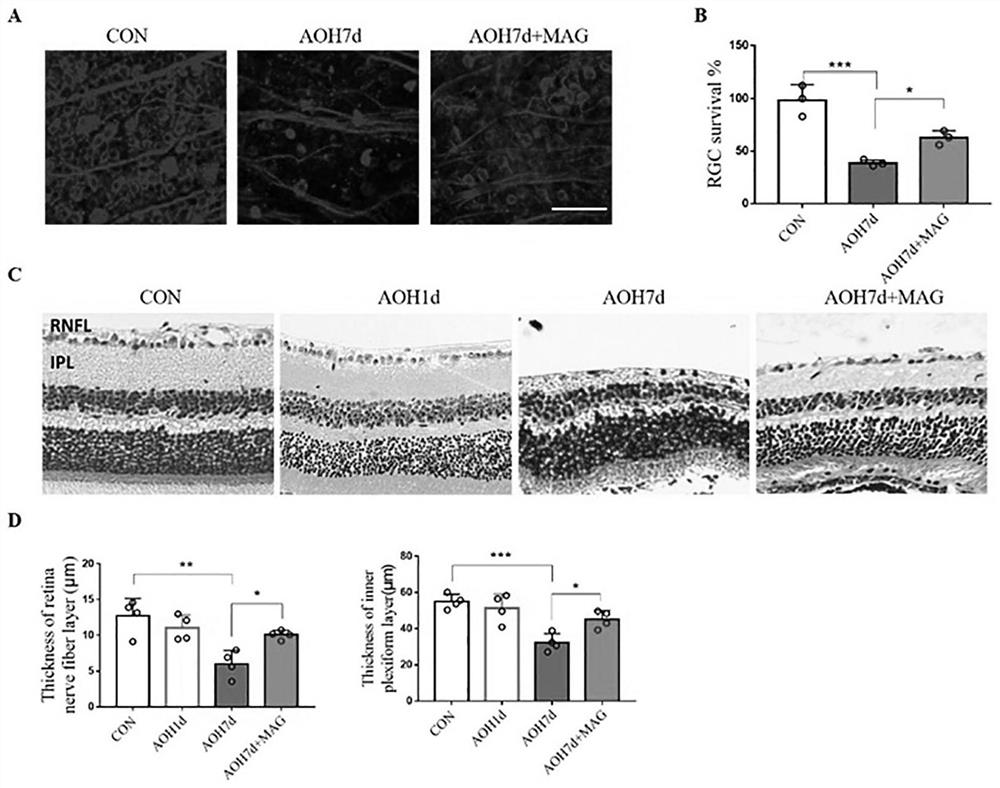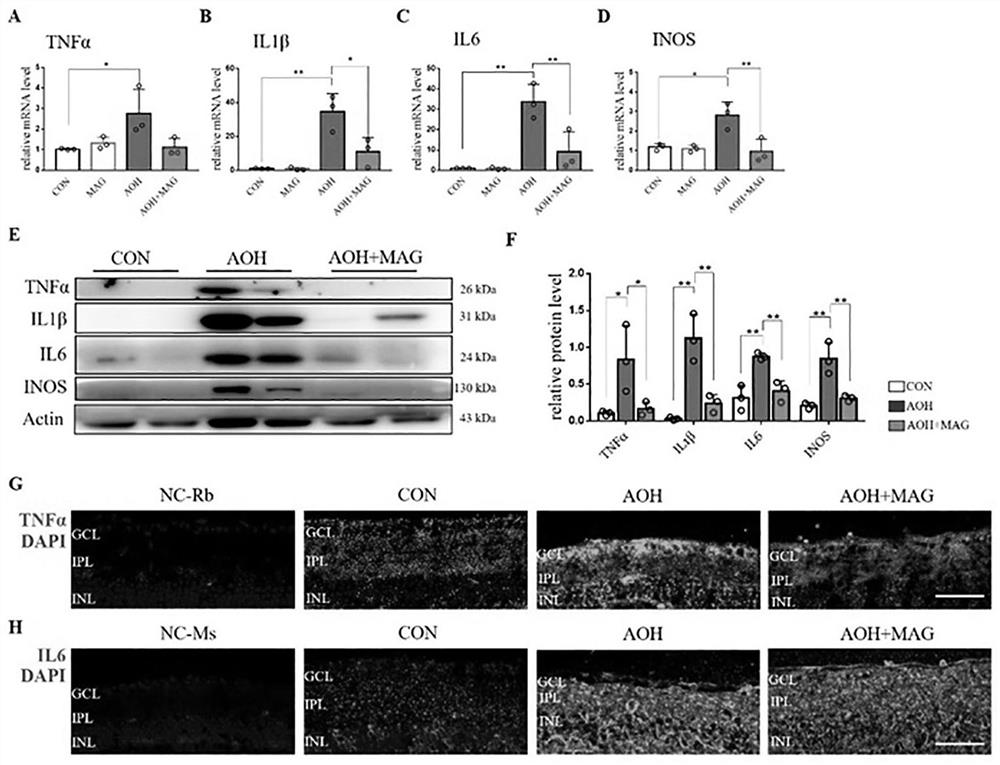New application of magnolol
A technology of honokiol and its purpose, applied in the field of medicine, can solve the problems of optic nerve protection that have not been reported, and achieve the effects of reducing the loss of retinal ganglion cells, improving retinal function, and maintaining stable properties.
- Summary
- Abstract
- Description
- Claims
- Application Information
AI Technical Summary
Problems solved by technology
Method used
Image
Examples
Embodiment 1
[0047] Example 1: Preparation of mouse intraocular hypertension model and honokiol intervention
[0048] 1. Establishment of mouse intraocular hypertension model:
[0049] All experiments were carried out under general anesthesia in mice, and the mice were purchased from Shanghai Jisijie Laboratory Animal Co., Ltd. 6-8 week old female C57BL / 6 mice were selected, anesthetized with zolitinib / dexmedetomidine mixture, and the right eye underwent high intraocular pressure injury. A 30-gauge needle was inserted into the anterior chamber. The needle was sterile with 100ml The isotonic saline bag was connected, the height of the saline bag was 120 cm from the mouse eyeball, and the injury was induced for 60 minutes. The intraocular pressure was measured at about 90 mmHg at this time. Mice without intraocular hypertension injury were used as a control group.
[0050] 2. Honokiol intervention:
[0051] Mice were injected intraperitoneally with honokiol (25 mg / kg, Selleckchem, Housto...
Embodiment 2
[0052] Example 2: Honokiol can improve the survival rate of retinal ganglion cells
[0053] 1. Assessment of optic nerve injury
[0054] Optic nerve damage was detected 7 days after IOP injury. The mouse hearts were perfused with normal saline for 5 minutes to remove blood cells, and then injected with 4% paraformaldehyde for 15 minutes for in situ fixation, and then the eyeballs were removed. Eyeballs were fixed with 4% PFA for 2 hours. Retinas were dissected to a tiled state, fixed with 4% PFA for 15 min, and permeabilized with 0.3% triton x-100 in PBS for 15 min. Retinas were blocked with 5% goat serum (Boster, CA, USA)-0.3% triton x-100 in PBS for 2 hours at room temperature, and then with β-III tubulin (a marker for RGCs; 1:1000; Abcam) 4°C overnight, followed by Alexa Fluor 594 anti-mouse secondary antibody (1:200; Abbkine, CA, USA). Four images were taken in each retinal intermediate region by confocal microscopy, and the immunopositive cells were counted with Image...
Embodiment 3
[0057] Example 3: Honokiol can inhibit retinal tissue thinning
[0058] 1. Histomorphological analysis
[0059] Mouse eyeballs were removed 1 and 7 days after ocular hypertension, and the eyeballs were fixed with 4% PFA overnight. Retinal thickness was assessed by morphological analysis of haematoxylin and eosin (H&E) stained retinal frozen or paraffin sections. Retinal nerve fiber layer (RNFL) and inner plexiform layer (IPL) thicknesses were measured on H&E images at the same distance from the optic nerve head and expressed as mean values.
[0060] 2. Analysis results
[0061] like figure 1 As shown in C-D, the thicknesses of retinal nerve fiber layer (RNFL) and inner plexiform layer (IPL) in the AOH1d group did not change significantly compared with the CON group, while the RNFL and IPL in the AOH7d group were significantly thinner compared with the CON group, while AOH7d The RNFL and IPL in the +MAG group increased in thickness compared with the AOH7d group. The experi...
PUM
| Property | Measurement | Unit |
|---|---|---|
| melting point | aaaaa | aaaaa |
Abstract
Description
Claims
Application Information
 Login to View More
Login to View More - R&D
- Intellectual Property
- Life Sciences
- Materials
- Tech Scout
- Unparalleled Data Quality
- Higher Quality Content
- 60% Fewer Hallucinations
Browse by: Latest US Patents, China's latest patents, Technical Efficacy Thesaurus, Application Domain, Technology Topic, Popular Technical Reports.
© 2025 PatSnap. All rights reserved.Legal|Privacy policy|Modern Slavery Act Transparency Statement|Sitemap|About US| Contact US: help@patsnap.com



